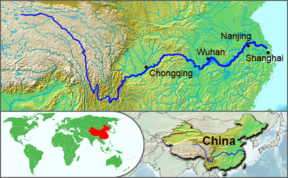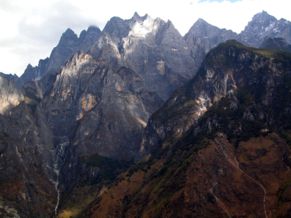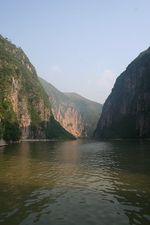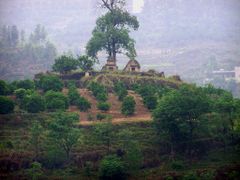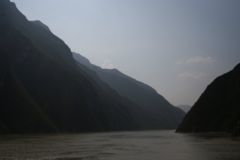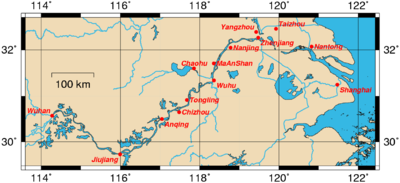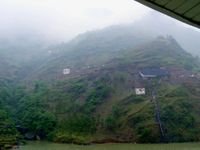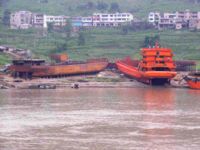Yangtze River
2007 Schools Wikipedia Selection. Related subjects: Geography of Asia
| Yangtze River | |
|---|---|
|
|
|
| Origin | Qinghai and Tibet in China |
| Mouth | East China Sea |
| Basin countries | China |
| Length | 6,211 km (3,859 mi) |
| Source elevation | 5,042 m (16,542 ft) |
| Avg. discharge | 31,900 m³/s (1,127,000 ft³/s) |
| Basin area | 1,800,000 km² (695,000 mi²) |
The Yangtze River or Chang Jiang ( Simplified Chinese: 长江; Traditional Chinese: 長江; pinyin: Cháng Jiāng) listen is the longest river in Asia and the third longest in the world after the Nile in Africa and the Amazon in South America.
The river is about 6,211 km long and flows from its source in Qinghai Province in western China, eastwards into the East China Sea. It has traditionally been considered a dividing point between northern and southern China, although geographers consider the Qinling- Huai River line to be the official line of geographical division.
Names
The name Yangtze River, as well as various similar names such as Yangtse River, Yangtze Kiang etc., is derived from Yangzi Jiang ( Simplified Chinese: 扬子江; Traditional Chinese: 揚子江; pinyin: Yángzǐ Jiāng) listen , the Chinese name for the river in its lower reaches. The modern Chinese name, Chang Jiang (长江/長江 Cháng Jiāng), literally means "long river" and is increasingly being adopted as the standard name in English.
Like many rivers, the Yangtze is known by different names over different parts of its course. At its source the river is known in Chinese as the Dangqu (当曲/當曲, from the Tibetan for "marsh river"). Downstream it is called the Tuotuo River (沱沱河) and then the Tongtian River (通天河, literally "pass to heaven river"). Where it runs through deep gorges parallel to the Mekong and the Salween before emerging onto the plains of Sichuan it is famous as the Jinsha River (金沙江 Jīnshā Jiāng, literally "golden sands river"). The name Yangzi was originally used by inhabitants of the river's lower reaches, downstream from Zhenjiang and Yangzhou in Jiangsu, and derives from the name of an ancient ferry crossing Yangzi Jin (扬子津/揚子津, literally "Mr, Yang's crossing"). Because it was the name first heard by missionaries and traders, it was applied in English to the entire river. In Chinese, Yangzi Jiang is considered a historical or poetic name for the river.
The Yangtze was earlier known to the Chinese as simply Jiang (江 Jiāng), a name which has become a generic name meaning "river," or the Da Jiang (大江 Dà Jiāng, literally "great river"). The Tibetan name for the river is Vbri-chu (འབྲི་ཆུ་, lit. "river of the female yak"). The Yangtze is sometimes referred to as the Golden Waterway.
Geography
The river originates in a glacier in the Dangla mountains on the eastern part of the Tibetan plateau. It then runs through the eastern part of Qinghai, turning southward down a deep valley at the border of Sichuan and Tibet to reach Yunnan. In the course of this valley, the river's elevation drops from above 5000 m to less than 1000 m. It enters the basin of Sichuan at Yibin. While in the Sichuan basin it receives several mighty tributaries, increasing its water volume significantly. The river then cuts through Mount Wushan bordering Chongqing and Hubei to create the famous Three Gorges. Eastward of the Three Gorges, Yichang is the first city on the Yangtze Plain. After entering Hubei, the Yangtze receives more water from thousands of lakes. The largest of these lakes is Dongting Lake, which is located on the border of Hunan and Hubei provinces, and is the outlet for most of the rivers in Hunan. At Wuhan it receives its biggest tributary, the Han River, bringing water from its northern basin as far as Shanxi. At the northern tip of Jiangxi, Lake Boyang, the biggest lake in China, merges into the river. The river then runs through Anhui and Jiangsu provinces, receiving more water from innumerable smaller lakes and rivers, and finally reaches the East China Sea at Shanghai. Four of China's five main freshwater lakes contribute their waters to the Yangtze River. Traditionally, the upstream part of the Yangtze River refers to the section from Yibin to Yichang; the middle part refers to the section from Yichang to Hukou, where Boyang Lake meets the river; the downstream part is from Hukou to Shanghai.
Characteristics
The Yangtze flows into the East China Sea and was navigable by ocean-going vessels up to a thousand miles from its mouth even before the Three Gorges Dam was built. As of June 2003, the Three Gorges Dam now spans the river, flooding Fengjie, the first of a number of towns affected by the massive flood control and power generation project. The project is the largest comprehensive irrigation project in the world. Proponents of the dam argue that it will free people living along the river from floods that have repeatedly threatened them in the past, and will also offer them electricity and water transport - though at the expense of permanently flooding many existing towns (including numerous ancient cultural relics) and causing large-scale changes in the local ecology.
Opponents of the dam point out that there are three different kinds of floods on the Yangtze River: floods which originate in the upper reaches, floods which originate in the lower reaches, and floods along the entire length of the river. They argue that the Three Gorges dam will actually make flooding in the upper reaches of the river worse and have little or no impact on floods which originate in the lower reaches. Twelve hundred years of low water marks on the river were recorded in the inscriptions and the carvings of carp at Baiheliang, now submerged.
The Yangtze River is flanked with metallurgical, power, chemical, auto, building materials and machinery industrial belts, and high-tech development zones. It is playing an increasingly crucial role in the river valley's economic growth and has become a vital link for international shipping to the inland provinces. The river is a major transportation artery for China connecting the interior with the coast. The Yangtze River is one of the world's busiest waterways. River traffic includes commercial traffic transporting bulk goods such as coal as well as manufactured goods and passengers. Cargo transportation on the Yangtze River reached 795 million tons in 2005 . River cruises of several days duration especially through the beautiful and scenic Three Gorges area are becoming popular as the tourism industry grows in China.
Flooding along the river has been a major problem. The rainy season in China is May and June in areas south of Yangtze River, and July and August in areas north of river. The huge river system receives water both from southern and northern flanks, which causes its flood season to extend from May to August. Meanwhile, the relatively dense population and rich cities along the river make the floods more deadly and costly. The most recent major floods were the 1998 Yangtze River Floods, but more disastrous were the 1954 Yangtze river floods, killing around 30,000 people. Other severe floods included those of 1911 which killed around 100,000, 1931 (145,000 dead), and 1935 (142,000 dead).
History
The Yangtze river occupies an important place in the cultural origins of southern China. Human activity was found in the Three Gorges area as far back as 2 million years ago, initiating debate over the origin of the Chinese people. In the Spring and Autumn Period, Ba and Shu were located in the western part of the river, covering modern Sichuan, Chongqing, and western Hubei; Chu was located in the central part of river, corresponding to Hubei, Hunan, Jiangxi, and southern Anhui. Wu and Yue were located in the eastern part of the river, now Jiangsu, Zhejiang, and Shanghai. Although the Yellow River region was richer and more developed at that time, the milder climate and more peaceful environment made the Yangtze river area more suitable for agriculture. From the Han Dynasty, the region of the Yangtze river became more and more important in China's economy. The establishment of irrigation systems (the most famous one is Dujiangyan, northwest of Chengdu, built during the Warring States period) made agriculture very stable and productive. Early in the Qing dynasty, the region called " Jiangnan" (includes the southern part of Jiangsu, the northern part of Zhejiang, and the southeastern part of Anhui) provided 1/3-1/2 of the nation's revenues.
Historically, the mighty Yangtze river became the political boundary between north China and south China several times (see History of China) because of the difficulty of crossing the river. A lot of battles took place along the river, the most famous being the Battle of Red Cliffs in 208 AD during the Three Kingdoms period. Politically, Nanjing was the capital of China several times, although most of the time its territory only covered the southeastern part of China, such as the Wu kingdom in the Three Kingdoms period, the Eastern Jin Dynasty, and smaller countries in the Northern and Southern Dynasties and Five Dynasties and Ten Kingdoms periods. Only the Ming occupied most parts of China from their capital at Nanjing, though it later moved capital to Beijing. The ROC capital was located in Nanjing in the periods 1911-1912, 1927-1937, 1945-1949.
Major cities along the river
- Panzhihua
- Yibin
- Luzhou
- Chongqing
- Yichang
- Jingzhou
- Shishou
- Yueyang
- Xianning
- Wuhan
- Ezhou
- Huangshi
- Huanggang
- Chaohu
- Chizhou
- Jiujiang
- Anqing
- Tongling
- Wuhu
- Hefei
- Chuzhou
- Maanshan
- Taizhou
- Yangzhou
- Zhenjiang
- Nanjing
- Nantong
- Shanghai
Tributaries
The Yangtze River has over 700 tributaries but the principal tributaries are the following:
- Yalong River
- Minjiang River
- Daduhe River
- Tuojiang River
- Jialing River
- Wujiang River
- Qingjiang
- Xiangjiang
- Lishui (Li)
- Zijiang ( Zi)
- Yuanjiang ( Yuan)
- Han River
- Ganjiang River
- Huangpu River
Trivia
- Cheung Kong Holdings, from the Cantonese language form of Chang Jiang and named after the river, is the name of the holding company controlled by Li Ka-Shing, one of Asia's richest tycoons.
- In 2004 Martin Strel from Slovenia swam the river from the Tiger Leaping Gorge to Shanghai (4600 km, 2860 miles).
- The Yangtze is home to (at least) three critically endangered species: The Chinese River Dolphin, the Chinese Alligator and the Chinese Paddlefish.
